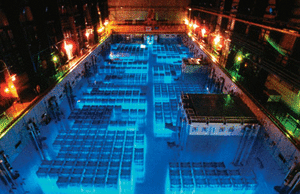Nuclear powerNuclear waste recycling for better nuclear power generation
Researchers aim to produce safe nuclear fuel that can be 80 percent recycled, compared to the current 1 percent; these fourth generation nuclear power systems can lead to a reduction of the amount of high-level, long-lived nuclear waste to a tenth of what it is today, while energy output can increase hundredfold

Nuclear fuel assemblies cooling in water pond // Source: jimdo.com
With a €9.4 million budget, a group of European researchers are collaborating to investigate nuclear fuel manufacturing and recycling for the fourth generation nuclear power systems. The aim is to produce safe fuel that can be 80 percent recycled, compared to the current 1 percent. Chalmers University of Technology in Gothenburg, Sweden, is in charge of the initiative.
A Chalmers University of Technology release reports that fourth generation nuclear power systems can lead to a reduction of the amount of high-level, long-lived nuclear waste to a tenth of what it is today, while energy output can increase hundredfold. Many researchers believe the new technology will have a commercial breakthrough within twenty years. Germany is at present the only European country that has decided to phase out nuclear power.
“The technology needed for the fourth generation already exists,” says Christian Ekberg, professor and nuclear chemistry research team leader at Chalmers. “What is needed now is for the different parts to be connected. One important aspect involves integrating nuclear waste recycling into the cycle so that nuclear power plants can be built with facilities to recycle waste and produce new nuclear fuel on site.”
Christian Ekberg is also the inaugural holder of Stena Metall’s professorship in Industrial Materials Recycling, and is the coordinator of the new research project called Asgard, which has received €5.5 million in EU grants.
Around fifty European researchers will take part in the project over four years.
“Traditionally, three different groups have worked separately on the fourth generation nuclear power systems: reactor physicists, fuel chemists and separation chemists. The groups will cooperate within the Asgard project to tie their previous findings together. We will also perform research on entirely new reactor fuels that are safer, use resources more effectively and that enable a more comprehensive approach to the waste issue.”
Oxides currently dominate among the nuclear fuels that are produced from recycled nuclear waste. One example is MOX fuel. During the course of the Asgard project, researchers will examine other types of chemical compounds with uranium or plutonium. Examples include nitrides and carbides. These chemical compounds are safer to use in reactors, amongst other things because their high melting point and thermal conductivity offer a higher safety margin in terms of a nuclear meltdown.
Researchers will now investigate whether the new fuels’ qualities are as positive in terms of recycling and production. At Chalmers — the European university best equipped to perform research on the entire nuclear fuel cycle — researchers will primarily concentrate on nitrides.
“If it is possible to recycle as much as we think, at least 80 per cent of nuclear waste will be possible to recycle,” says Christian Ekberg. “This would also mean that eight times as much of the remaining waste could be included in the final repository, since heat generation is reduced. In addition, the amount of long-lived nuclides in residual waste is reduced, which results in a significantly shorter storage period. However, it is important to remember that the final repository is still an important part of the fuel cycle.”
